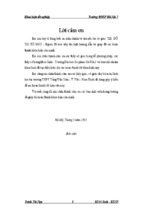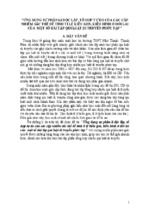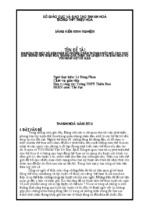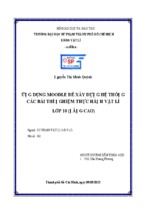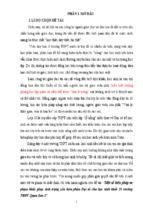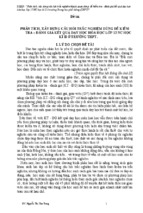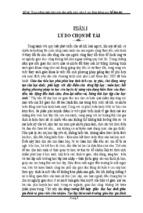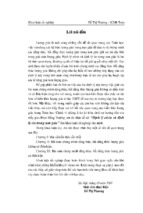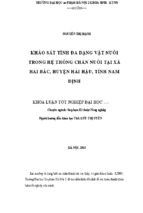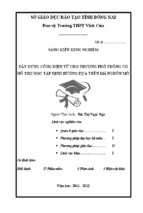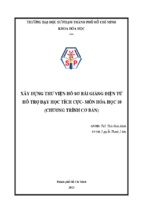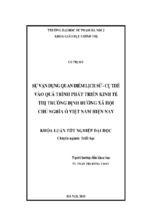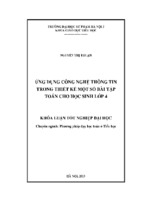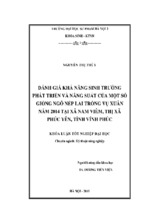DEVELOPING LISTENING SKILLS
________________________________________________________________________________________________
EDUCATION AND TRAINING
DEPARTEMENT OF DONG NAI PROVINCE
PHUOC THIEN HIGH SCHOOL
CODE: ………………
EXPERIENCE INITIATIVE
DEVELOPING LISTENING SKILLS
Written by: ĐOÀN THỊ HỒNG HOA
Research area:
Education management:……………….
English teaching method: English
Othe fields:……….…………….
Enclosed with:
Model software
Film and picture
other related things
SCHOOL YEAR: 2011-2012
1
DEVELOPING LISTENING SKILLS
________________________________________________________________________________________________
CURRICULUM
I. PERSONAL INFORMATION
1. Họ Full name: Đoàn Thị Hồng Hoa
2. Date of birth: 20th, June 1977
3. Male / female: female
4. Address: An Phuoc village, Long Thanh district, Dong Nai province
5. Phone number: 0919503336
6. Fax:
Email:
7. Career: English Teacher
8. Work at: Phuoc Thien High School
II. EDUCATION
- University: B.A in English
- Year graduated: 1999
- Trained speciality: English
III. EXPERIENCE
- Experienced professional field:
- Year of Teaching : 13
- Recently written theme:
2
DEVELOPING LISTENING SKILLS
________________________________________________________________________________________________
CONTENTS
I. INTRODUCTION
II. CONTENTS
A.THEORETICAL BACKGROUND
1. What is listening?
2. Why teach listening?
3. Two ways of listening
B. CONTENTS
1. WARM – UP EXERCISES
a. Using Pictures
b. Questions and Answers
c. Brainstorm
d. Describe the Picture
2. STAGES OF A LISTENING LESSON
a. Pre-listening stage
b. While-listening stage
c. Post-listening stage
3. WHAT IF STUDENTS DO NOT UNDERSTAND THE LISTENING TAPE?
4. LISTENING PROBLEMS AND STRATEGIES TO DEAL WITH THEM
III.CONCLUSION
IV. REFERENCES
3
DEVELOPING LISTENING SKILLS
________________________________________________________________________________________________
I.INTRODUCTION
Phuoc Thien High school is one of the prestigious schools in Dong nai province. It
has 25 classes with over 1000 students each year. As common in other high
schools in Vietnam, the students in this school have to take English as
compulsory subject in the curriculum and study it four periods a week ( 1 period
= 45 minutes), for 37 weeks a year. Most of the students in my class are not good
at listening English. In discussion with them, I know that they already want to
improve their listening skills. However, their listening is poor because they do
not have much time to practise listening. Therefore, in order to promote the
students’ listening skills, I would like to suggest some strategies for developing
listening skills.
II.CONTENTS
A.THEORETICAL BACKGROUND
1. What is listening?
Listening is the ability to identify and understand what others are saying. This
involves understanding a speaker’s accent or pronunciation, his grammar and his
vocabulary, and grasping his meaning (Goh, 2002). An able listener is capable of
doing these four things simultaneously. Willis (1981, p.134) lists a series of microskills of listening, which she calls enabling skills. They are:
• guessing at unknown words or phrases without panicking
• predicting what people are going to talk about
• using one’s own knowledge of the topic to help one understand
• identifying relevant points; rejecting irrelevant information
• retaining relevant points (note-taking, summarizing)
• recognizing discourse markers, e.g., Well; Oh, another thing is; Now, finally; etc.
• recognizing cohesive devices, e.g., such as and which, including link words,
pronouns, references, etc.
• understanding inferred information, e.g., speakers’ attitude or intentions
• understanding different intonation patterns and uses of stress, etc., which give clues
to meaning and social setting
2. Why teach listening?
Listening is an important skill and probably the most difficult one. Getting students
to listen to spoken English is to let them hear different accents and varieties apart from
their teacher and that way better prepare them for real world listening. The main
4
DEVELOPING LISTENING SKILLS
________________________________________________________________________________________________
method of exposing them to spoken English other than their teacher’s is using taped
material that exemplify a wide range of topic such broadcast news, announcement,
advertisement, etc.
From a theoretical perspective, teaching listening will help them acquire the
language subconsciously even when the teacher does not draw their attention to special
features. It is agreed that exposure to the target language is a fundamental requirement
for those who want to learn it. The use of tape material will provide students with such
exposure and they will get information not only vocabulary and structure but also
pronunciation, rhythm, intonation, pitch and stress.
3. Two ways of listening
In real life, there are two ways in which we often listen:
- ‘Casual’ listening: Sometimes we listen with no particular purpose in mind, and
often without much concentration. Examples of this kind of listening are :
listening to the radio while doing some homework; chatting to a friend. Usually
we do not listen very closely, unless we hear something that particularly
interests us, and afterwards we may not remember much of what we hear.
- ‘Focussed’ listening: At other times we listen for a particular purpose, to find
out information we need to know. Examples of this kind of listening are:
listening to a piece of information news on the radio; listening to someone
explaining how to operate a machine. In these situations, we listen much more
closely; but we do not listen to everything we hear with equal concentration –
we listen for the most important points or for particular information. Usually,
we know beforehand what we are listening for ( the things we want to know),
and this helps us to listen.
In class, we are usually concerned with the second kind of listening : we expect the
students to listen closely and remember afterwards what they heard. But if we just
ask the class to ‘listen’ and we ask questions afterwards, we are giving them a
very difficult task. We can make it easier by telling them beforehand what to
expect and what to listen for - this will help them to focus their listening.
The traditional way of teaching, such as, introducing some new difficult words,
listening to the tape again and again and then giving correct answers, still prevails. It is
not difficult for us to see how detrimental such a listening class is to learners. Such an
approach to "teaching" listening is more like "testing" listening, because listeners are
simply exposed to a succession of listening texts on a tape, and then are tested how
5
DEVELOPING LISTENING SKILLS
________________________________________________________________________________________________
much they have understood in terms of a lot of comprehension exercises rather than
being taught how to listen and how to cope with their listening problems in the class.
Many students complained that they became tired of listening to the tape from
beginning to the end with some mechanical exercises. Without interest, motivation and
variation in teaching and learning, students felt bored in listening classes. As a result,
the passive attitude kept students from making much progress in listening
comprehension. In this paper, what we want to discuss is how to make listening classes
more interesting and how to develop students' listening ability.
Just as Broughton says, "motivation is a basic principle of all kinds of teaching - the
language student is best motivated by practice in which he senses the language is
truly communicative, that it is appropriate to its context, that his teacher's skills
are moving him forward to a fuller competence in the foreign language." So, how
to keep students' interest in learning must be focused. Unfortunately, some
English teachers often pay more attention to 'filling' the students with many
mechanical exercises, ignoring the interest and motivation in class.
B. CONTENTS
1. WARM – UP EXERCISES
The Importance of Warm-up Exercises
In class, we must try to avoid boring or over-theoretical or mechanical subjects,
using as far as possible warm-up exercises we think our students may be interested in,
that seem of practical relevance, that may arouse or stimulate them. Sometimes, a
picture or a humorous story can do a great deal towards arousing interest among
students. However, during the whole listening course, most teachers actually only have
a 'while-listening' stage, neglecting the 'pre-listening or warm-up exercise step, which
acts as an important role in arousing students' interest and as the preparation stage for
the 'while-listening' stage.
As a matter of fact, we can say that how well students had done in class depends
mostly on how well they had been warmed up. From this point of view, English
teachers should start taking concrete measures to reconsider the methodology they can
apply in their listening courses and try to improve their teaching of listening from a
new approach. We should use some techniques that are effective and interesting in
teaching listening courses, thinking as much as possible about the needs of students
concerned.
6
DEVELOPING LISTENING SKILLS
________________________________________________________________________________________________
a. Using Pictures
I often use pictures in listening class. Pictures have the advantage of being easy to
prepare, easy to organize, being interesting, meaningful and authentic. Pictures can
bring images of reality into the unnatural world of the language classroom. Pictures are
useful in developing students' listening comprehension, particularly 'directed listening'
They not only help to guide the student' listening, they can provide a general
background and context. They especially contribute to interest and motivation. For
example, try this "spot the similarity" activity.
Ask the students to get into pairs, give each student or pair of students a picture
that the other(s) must not see.
Tell them that they have pictures that are very different from each other, and ask
them to describe these pictures to each other with the aim of finding as many
similarities as they can.
After several minutes, ask them to look at the two pictures and see what other
similarities they can find.
Sometimes, I read descriptions of faces, maps, diagrams for students to draw. No
matter how well or badly they had done, students were so happy to have the chance to
listen, speak, and do something interesting in the listening class which they once
considered a 'sleeping course'.
Unit 11: National Parks ( Grade 10 )
I stick 2 pictures and ask my students to look at these pictures and discuss the
questions :
1. Where is Nairobi National park ?
2.Is Everglades National Park a sub-tropical wilderness in southeastern United States ?
7
DEVELOPING LISTENING SKILLS
________________________________________________________________________________________________
Then I introduce the new lesson.
b. Questions and Answers
Some people might think that asking questions is a purely technical (i. e.
grammatical) matter. But in my class, it is not. As a matter of fact, no matter how
effective a technique is, listening comprehension should demand students'
participation, and the immediate feedback helps keep interest and motivation.
"Question Time" is the name I have given to those first five to ten minutes of a lesson.
Before listening to a passage, I always asked some questions so that students would
have some ideas about the topic before they listened. In this process of doing the
warm-up activity, students could build on their prior knowledge and at the same time,
use vocabulary and structures that are connected with a particular function.
For example , when teaching the students unit 12 in English 10 with the title Music,
I encourage my students to discuss the questions below:
1. Do you know Van Cao?
2. What’s his job?
3. When/ where was he born?
4. Is he still alive?
5. When did he die?
6. Which of the songs were written by him?
After that I intruduce the topic : Today you are going to listen to an interview in
which Lan Huong, the interviewer, asks Quang Hung, a famous actor about Van
Cao.
8
DEVELOPING LISTENING SKILLS
________________________________________________________________________________________________
In this way, students can be aware of the purpose of the exercise in general and the
nature of the specific task in particular before they listen to the passage. The "Question
Time" activity can do much in listening classes, such as creating a friendly atmosphere
between the teacher and the students, building the students' confidence and having the
thrill of something spontaneous. Above all, it makes students feel interested and gets
them involved in the listening activities.
c.Brainstorm
I give a topic and ask learners to think of anything related to it. I write the
responses for all to see, or ask a volunteer to do the writing. I can use this to elicit
vocabulary related to your lesson.
Ex : Unit 3: People’s background ( Grade 10 )
I ask my students to work in pairs and talk about Olympic and Olympic
Champions.
Suggest the questions:
1. What do you know about Olympic ?
2. What do you know about Olympic champions?
3. What do you want to know about an Olympic champion ?
Then I gather ideas that my students discuss and give some background
information about Olympic and Olympic Champions.
d. Describe the Picture
I show a picture and have learners take turns saying one descriptive thing about
it. Beginners can make simple observations like "three cats" while advanced
students can make up a story to go with the picture. They aren't allowed to repeat
what someone else said, so they need to pay attention when each person speaks.
Variation for individual: take turns with the teacher.
Ex : Unit 8 : The story of my village ( Grade 10 )
I ask students to work in pairs to discuss the differences between the two
pictures .
9
DEVELOPING LISTENING SKILLS
________________________________________________________________________________________________
2. STAGES OF A LISTENING LESSON
a. Pre-listening stage
This stage prepares students by getting them to think about the topic or situation
before they listen to the texts. In other words, it gives students a purpose to listen. It
also gets students to relate to what they already know about the topic and not least
important arouse their interest in listening.
There are certain goals that should be achieved before students attempt to listen to any
text. These are motivation, contextualization, and preparation.
Motivation
It is enormously important that before listening students are motivated to listen, so
you should try to select a text that they will find interesting and then design tasks that
will arouse your students' interest and curiosity.
Contextualization
When we listen in our everyday lives we hear language within its natural
environment, and that environment gives us a huge amount of information about the
linguistic content we are likely to hear. Listening to a tape recording in a classroom is
a very unnatural process. The text has been taken from its original environment and we
need to design tasks that will help students to contextualize the listening and access
their existing knowledge and expectations to help them understand the text.
Preparation
To do the task we set students while they listen there could be specific vocabulary or
expressions that students will need. It's vital that we cover this before they start to
listen as we want the challenge within the lesson to be act of listening not of
understanding what they have to do.
Pre-tasks can be:
- Introducing general content of the listening passage
- Making use of pictures (if any) to present new vocabulary
- Presenting more words/phrases from tape scripts
- Getting students to pronounce words/phrases carefully
- Reviewing already-presented grammatical patterns
- Presenting new grammatical patterns (if any)
- Asking students to predict content of the listening
Ex:Unit 1: A day in the life of......(Grade 10)
10
DEVELOPING LISTENING SKILLS
________________________________________________________________________________________________
-I hang the picture of a man who drives a cyclo and introduce:
He has a cyclo.
He works in the streets.
He drives people from one place to another.
-Then I put a question:
Who is he?
- After that I lead to the new lesson: Mr. Lam is a cyclo driver. He is
working in HCM city. Let’s guess his routine. What does he do in his job?
- I ask students to work in pairs to ask and answer questions in page 16
Answer the questions:
1.Have you ever travelled by cyclo?
2.When was it?
3.Is it interesting to travel by cyclo?
4.Which do you prefer, going by cyclo or by bicycle?
5.Give reasons?
I teach some new words.
-district(n) ): an administrative division, smaller than a province
-Passengers (n): people who travel on a train, bus..
-routine(n)
-pedal(n)
- food stall(n) : small booth, compartment or kiosk in / near a market where food is sold
- drop (v)
Then I introduce the new lesson.
b. While-listening stage
This stage gives students a 'guide' or framework to help them practice listening. In
other words, it helps students to listen better, more accurately, thoroughly through
carefully designed comprehension tasks.
When we listen to something in our everyday lives we do so for a reason. Students too
need a reason to listen that will focus their attention. Ideally the listening tasks that are
designed should guide them through the text. What the teacher do to facilitate
students’ comprehension:
- Giving clear instructions for the listening task (rephrasing textbook instructions if
necessary)
- Playing the tape once (non-stop) for students to get general content of the listening
11
DEVELOPING LISTENING SKILLS
________________________________________________________________________________________________
- Providing other activities from textbook for slower classes
- Moving from simpler tasks (listening for getting key words/phrases, listening for
main ideas, matching, deciding on true/false information, numbering pictures,
sequencing events…) to more complicated ones (answering MCQs, gap-filling,
table/graph completing, answering information questions …)
- Playing the tape several times (non-stop or with pauses if students need help)
- Breaking long tapescripts into sections to facilitate the listening
3. Post-listening stage
The Post-stage is like the follow-up stage. After students have practiced the target skill
in the While-stage, they do an extension activity. This helps students take the
information or whatever they have produced in the While-stage, and do something
meaningful with it.
There are two common forms that post-listening tasks can take. These are reactions to
the content of the text, and analysis of the linguistic features used to express the
content.
Reaction to the text
Of these two I find that tasks that focus students reaction to the content are most
important. Again, this is something that we naturally do in our everyday lives. Because
we listen for a reason, there is generally a following reaction. This could be discussion
as a response to what we have heard - do they agree or disagree or even believe what
they have heard? - or it could be some kind of reuse of the information they have
heard.
Analysis of language
The second of these two post-listening task types involves focusing students on
linguistic features of the text. This is important in terms of developing their knowledge
of language, but less so in terms of developing students' listening skills. It could take
the form of an analysis of verb forms from a script of the listening text or vocabulary
or collocation work. This is a good time to do form focused work as the students have
already developed an understanding of the text and so will find dealing with the forms
that express those meanings much easier.
3. WHAT IF STUDENTS DO NOT UNDERSTAND THE LISTENING TAPE?
12
DEVELOPING LISTENING SKILLS
________________________________________________________________________________________________
Introduce interview questions: Questions can be given first and students are
encouraged to role-play the interview before listening. This will increase their
predictive power.
Use ‘jigsaw listening’: Different groups are given different bits of the tapescript.
When the groups hear about each other’s pieces of tapescript, they can get the whole
picture.
One task only: Non-demanding tasks can be assigned such as listening and deciding
on the sex, age, status of the speaker or the setting of the listening.
Use the tapescript: (1) it can be cut into bits for students to put in the right order as
they listen; (2) students can look at the tapescript to gain more confidence and ensure
what the tape is about; and (3) students can look at the tapescript before, during, or
after they listen. The tapescript can also have words or phrases blanked out.
c. Post-listening stage
The Post-stage is like the follow-up stage. After students have practiced the target skill
in the While-stage, they do an extension activity. This helps students take the
information or whatever they have produced in the While-stage, and do something
meaningful with it.
There are two common forms that post-listening tasks can take. These are reactions to
the content of the text, and analysis of the linguistic features used to express the
content.
Reaction to the text
Of these two I find that tasks that focus students reaction to the content are most
important. Again, this is something that we naturally do in our everyday lives. Because
we listen for a reason, there is generally a following reaction. This could be discussion
as a response to what we have heard - do they agree or disagree or even believe what
they have heard? - or it could be some kind of reuse of the information they have
heard.
Analysis of language
The second of these two post-listening task types involves focusing students on
linguistic features of the text. This is important in terms of developing their knowledge
of language, but less so in terms of developing students' listening skills. It could take
13
DEVELOPING LISTENING SKILLS
________________________________________________________________________________________________
the form of an analysis of verb forms from a script of the listening text or vocabulary
or collocation work. This is a good time to do form focused work as the students have
already developed an understanding of the text and so will find dealing with the forms
that express those meanings much easier.
For example , when teaching the students unit 2 in English 10 with the title
SCHOOL TALKS I suggest the common problems at school:
Getting bad marks
Having difficulty in making friends
Coming to class late
Be slow at learning…
I ask students to work in groups, discuss the problems they have experienced at
school. During the discussion, I give students some questions:
What problems have you got at school?
What is / are the reason (s)?
What have you done to solve it / them?
Who helps you to solve it?
UNIT 4: SPECIAL EDUCATION / LESSON 3 / LISTENING
- I ask my students to work in groups of 4 to complete the questions and then ask
and answer about the Vang Trang Khuyet Club.
1/ What/ name/ the club?
2/ Who/ members/ the club?
3/ Where/ they/ come//?
4/ What/ they/ doing/ HaNoi?
5/ How many/ photographs/ display?
6/ What/ their photos/ about?
7/ What/ their passion/ taking photographs/ help/ them?
4. PRINCIPLES OF TEACHING LISTENING
Expose students to different types of learning
As mentioned earlier, there are different types of learning for different purposes.
Students thus should consider their reasons for and experience various types of
listening from listening for general understanding or specific information, etc.
Teach a variety of tasks
14
DEVELOPING LISTENING SKILLS
________________________________________________________________________________________________
Students also need to work with different types of tasks because through one type of
task students’ comprehension skills cannot be fully assessed. For example, if the
teacher gets students to do True/False exercise, there will be 50% of chance that they
get it right without actually hearing anything from the text.
Train students to listen
Some strategies that may help students learn and monitor their learning are predicting;
inferring – listen between the lines; monitoring – notice what they do and don’t
understand to clarify by asking questions (e.g. What does ___ mean?) or giving
feedback (e.g. I don’t understand); or responding to show what they hear and finally
evaluating – check on how well they have understood.
The tape recorder is just as important as the tape
As we discussed earlier, the low quality of sound is one of the barrier in listening
lesson. So the tape recorder should offer an audible sound so that the tape can be heard
around the classroom. A tape recorder with counter – which helps you see where you
are in the tape – is a good idea. For long listening texts, noting down the counter
numbers will help teachers go back or forward easily without frustration. If you want
to play music, think of a better machine.
Preparation is vital
The teacher should go through the tape before class so that she will be prepared for
any problems, noises, accents, etc that come up. That way, she can judge if the
students are able to cope the tape and the tasks that go with it.
Students should be made ready to listen, too. That mean they should discuss the topic,
look at pictures, etc to be able to predict what is coming. They should be engaged to
the topic and the task so that they really want to listen.
Once will not be enough
The first listening is often used just to give students an idea of what the material
sounds like. Students will want to hear again to pick up what they missed at the first
hearing. Besides, the teacher may want to draw attention to language used in the tape.
However, the students may not want to hear again many more after 2-3 times.
Students should be encouraged to respond to the content, not just the language
The most important part of listening practice is to draw out the meaning, the intended
message, what impression it makes on the listeners. So ask questions that relate to their
15
DEVELOPING LISTENING SKILLS
________________________________________________________________________________________________
own experience e.g. “Do you agree?” is as important as “What language he used to
invite her?”
Different stages require different tasks
At pre-stage, questions should be straightforward and rather general to help activate
students’ knowledge and language relating to the topic while more complicated and
detailed questions should be reserved for later stages.
Listening tasks should teach students to listen, not test their listening ability
Many comprehension tasks fall somewhere between teaching and testing. In testing,
we want to see how well students perform. More than few teachers are attempted to
expect students to give correct answers right away after a couple of times listening
without preparation beforehand and guide along away.
5. LISTENING PROBLEMS AND STRATEGIES TO DEAL WITH THEM
a. What are Some Listening Problems?
Content
Unlike reading or speaking where you somewhat control the pace you want to go
about the language, when listening to the tape, it just goes at the same speech for all
and won't stop even when you are lost. And when don’t recognize some words or
phrases and stop to think, you miss next part and soon fall behind in terms of
comprehension.
The listening material may deal with almost any area of life. It might include street
gossip, proverbs, new products, and situations unfamiliar to the student. Also, in a
spontaneous conversation speakers frequently change topics.
The content is usually not well organized like a reading text.
In many cases listeners cannot predict what speakers are going to say, whether it is a
news report on the radio, an interviewer’s questions, an everyday conversation, etc.
Linguistic features
Liaison (the linking of words in speech when the second word begins with a vowel)
and elision (leaving out a sound or sounds, e.g., suppose may be pronounced /spouz/ in
rapid speech) are common phenomena that make it difficult for students to distinguish
or recognize individual words in the stream of speech. They are used to seeing words
written as discrete entities in their textbooks.
16
DEVELOPING LISTENING SKILLS
________________________________________________________________________________________________
If listening materials are made up of everyday conversation, they may contain a lot of
colloquial words and expressions, such as stuff for material, guy for man, etc., as well
as slang. Students who have been exposed mainly to formal or bookish English may
not be familiar with these expressions.
In spontaneous conversations, people sometimes use ungrammatical sentences because
of nervousness or hesitation. They may omit elements of sentences or add something
redundant. This may make it difficult for the listener to understand the meaning.
Speaker
Learners tend to be used to their teacher’s accent or to the standard variety of British
or American English. They find it hard to understand speakers with other accents.
Spoken prose, as in news broadcasting and reading aloud written texts, is characterized
by an even pace, volume, pitch, and intonation. Natural dialogues, on the other hand,
are full of hesitations, pauses, and uneven intonation. Students used to the former
kinds of listening material may sometimes find the latter difficult to understand.
Listener
Foreign-language students are not familiar enough with clichés and collocations in
English to predict a missing word or phrase. They cannot, for example, be expected to
know that rosy often collocates with cheeks nor to predict the last word will be
something like rage when they hear the phrase he was in a towering. . . . This is a
major problem for students.
Lack of socio-cultural, factual, and contextual knowledge of the target language can
present an obstacle to comprehension because language is used to express its culture
(Anderson and Lynch, 1988).
Foreign-language learners usually devote more time to reading than to listening, and
so lack exposure to different kinds of listening materials. Even our college students
majoring in English have no more than four hours’ regular training per week.
Physical Setting
Noise, including both background noises on the recording and environmental noises,
can take the listener’s mind off the content of the listening passage.
Listening material on tape or radio lacks visual and aural environmental clues.
17
DEVELOPING LISTENING SKILLS
________________________________________________________________________________________________
Not seeing the speaker’s body language and facial expressions makes it more difficult
for the listener to understand the speaker’s meaning.
Unclear sounds resulting from poor-quality equipment can interfere with the listener’s
comprehension.
b. Some solutions
Not all the problems described above can be overcome. Certain features of the
message and the speaker, for instance, are inevitable. But this does not mean that the
teacher can do nothing about them. S/he can at least provide the students with suitable
listening materials, background and linguistic knowledge, enabling skills, pleasant
classroom conditions, and useful exercises to help them discover effective listening
strategies. Here are a few helpful ideas:
Listening text
1. Grade listening materials according to the students’ level, and provide authentic
materials. Nevertheless, the materials should progress step by step from semiauthenticity that displays most of the linguistic features of natural speech to total
authenticity, because the final aim is to understand natural speech in real life.
2. Design task-oriented exercises to engage the students’ interest and help them learn
listening skills besides the language. As Ur (1984:25) has said, “Listening exercises
are most effective if they are constructed round a task. That is to say, the students are
required to do something in response to what they hear that will demonstrate their
understanding.” Task-based exercises - like expressing agreement or disagreement,
taking notes, marking a picture or diagram according to instructions, and answering
questions - have an obvious advantage: they not only test the students’ listening
comprehension but also encourage them to use different kinds of listening skills and
strategies to reach their destination in an active way.
3. Provide students with different kinds of input, such as lectures, radio news, films,
TV plays, announcements, everyday conversation, interviews, storytelling, English
songs, and so on.
4. Try to find visual aids or draw pictures and diagrams associated with the listening
topics to help students guess or imagine actively.
Speaker
18
DEVELOPING LISTENING SKILLS
________________________________________________________________________________________________
1. Give practice in liaisons and elisions in order to help students get used to the
acoustic forms of rapid natural speech; include the teaching of such aspects in the
lesson.
2. Make students aware of different native-speaker accents. Of course, strong regional
accents are not suitable for training in listening, but in spontaneous conversation native
speakers do have certain accents. Moreover, the American accent is quite different
from the British and Australian. Therefore, it is necessary to let students deal with
different accents, especially in extensive listening.
Listener
1. Provide background knowledge and linguistic knowledge, such as complex sentence
structures and colloquial words and expressions before the listening task, as needed.
2. Give, and try to get, as much feedback as possible. Throughout the course the
teacher should bridge the gap between input and students’ response and between the
teacher’s feedback and students’ reaction in order to keep activities purposeful. It is
important for the listening-class teacher to give students immediate feedback on their
performance. This not only promotes error correction but also provides
encouragement. It can help students develop confidence in their ability to deal with
listening problems. Student feedback can help the teacher judge where the class is
going and how it should be guided.
3. Help students develop the skills of listening with anticipation, listening for specific
information, listening for gist, interpretation and inference, listening for intended
meaning, listening for attitude, etc., by providing varied tasks and exercises at different
levels with different focuses.
III.RESULT
The above activities can be used as strategies for developing listening skills that
cultivate students' interest and help students enjoy their listening course. The activities
have a positive affect on students and make them want to listen and speak more. After
one year's practice, the students in my class had better understanding and speaking
ability. Above all, the students had the habit of listening to English after class, such as
listening to radio, tapes and so on.
IV. EXPERIENCE LESSON
There are different methods of teaching English, but the most important thing is that we
must use the one that works in a certain situation. Actually, various activities in each lesson
can help with making students more dynamic and active. What I will do is to make effective
19
DEVELOPING LISTENING SKILLS
________________________________________________________________________________________________
use of all four skills: listening, speaking, reading and writing. I can teach speaking through
reading, listening, speaking, and writing and vice versa . One more important thing I should
do is implementing task-based teaching. Tasks must be varied, challenging and interesting
enough to hold students’ interest in communication. Tasks must also be relevant to students’
needs, such as their jobs or target situations.
Of course, listening comprehension is a complex activity involving a large number
of different skills and activities. No small set of exercises can possibly satisfy the
needs of most students. No one correct learning strategy will work for all students at
all times. So, English teachers should have a large battery of different exercises
designed to give practice in most of these various skills. Moreover, listening should be
taught with motivation, interest and variation so students can keep their interest in it.
As a result, students can make good progress in listening comprehension.
V.CONCLUSION
With my little knowledge and study in reference books, I hope to contribute my
little ideas in teaching English at senior high school. In process of
implementation,there should certainly be errors or omissions, so I am looking forward
to receiving your comments on my topic so that I may more and more improve my
teaching English.
Thank you very much.
VI. REFERENCES
-“Listening in a foreign language” by Ana Maria Schwartz, in Modules for the
professional preparation of teaching assistants in foreign languages (Grace Stovall
Burkart, ed.; Washington, DC: Center for Applied Linguistics, 1998)
-The Teaching of Listening- Arif Saricoban Hacettepe -University (Beytepe-Ankara,
Turkey)
20
- Xem thêm -




